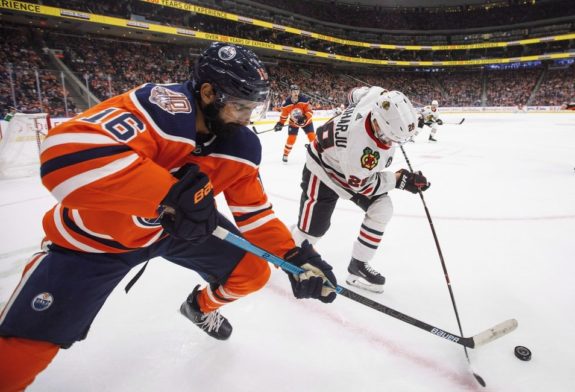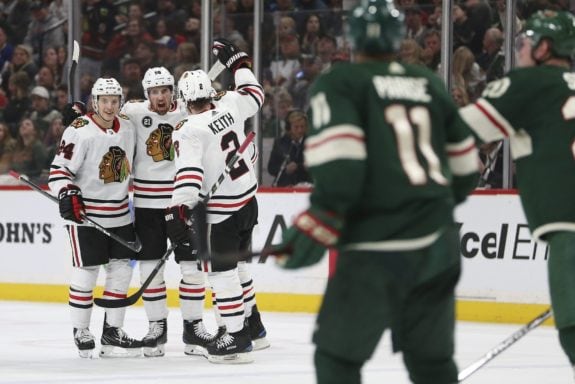The Chicago Blackhawks had a perfectly good thing going with defenceman Henri Jokiharju, before they banished him to the American Hockey League. He played 37 games for the Blackhawks prior to the announcement that he would be heading to Rockford.
Head coach Jeremy Colliton said at the time that he wanted Jokiharju to play more and that, “I think he’ll be a power-play guy, a top guy. I think he can do that here, but he wasn’t getting that opportunity.”
Through 37 games, his underlying numbers were fantastic, and he found himself leading the Blackhawks with a 53.94 percent Corsi for (CF%). Overall, he was positioned anywhere from first to fifth on the Blackhawks in most categories. At the time he was sent away, he was averaging the fifth-most minutes per game by a defenceman at 5-v-5 for Chicago. In reality, he saw his minutes significantly deteriorate when Colliton took over behind the bench.

Splitting Jokiharju’s Season in Two
Jokiharju played 38 games in total, being recalled for one more game after heading to Rockford to join the IceHogs. Former Blackhawks coach Joel Quenneville got removed from behind the bench 15 games into the season, and Colliton didn’t start the ice-time decline until Game 20. This makes it easy for a 19-game comparison. Let’s look at the first block of games, Oct. 4-Nov. 15. The ranking is among defencemen with a minimum of 100 minutes at 5-v-5 – relCF/60 = relative Corsi for/60 minutes; relCA/60 = relative Corsi against/60; xGF% = expected goals for percentage
| TOI/Gm | CF% | relCF/60 | relCA/60 | xGF% | |
| Number | 18:49 | 56.06 | 10.29 | -6.61 | 47.76 |
| Rank | 1st | 1st | 1st | 1st | 2nd |
Jokiharju was an important player for the Blackhawks during this period. That shows in every statistic you look at. Unfortunately, the team didn’t enjoy success. That shouldn’t take away from the positive influence he was on the ice. While he was logging big minutes, the Blackhawks were getting quality results. They controlled 56.06 percent of the shot attempts, an excellent total.
The second block of games, Nov. 16-Feb. 22, saw a drop in everything, with the exception of CA/60. Even still, Jokiharju remained near the top in the same categories.
| TOI/Gm | CF% | relCF/60 | relCA/60 | xGF% | |
| Number | 14:02 | 51.29 | 5.5 | -3.49 | 48.31 |
| Rank | 9th | 2nd | 2nd | 3rd | 3rd |
As his time dropped, so did nearly all of his statistics. It’s also worth noting that, to further muddy the picture, his defensive zone starts were higher while his statistics were higher. In the first block of games, Jokiharju had 14.94 defensive zone starts per 60 minutes. In the second block of games, he had 12.37.
It would have been just as easy for Colliton to play Jorkiharju more in Chicago rather than demote him. The Blackhawks weren’t their regular powerhouse selves in 2018-19, so it’s not as if he was in a large competition with his peers.

Jokiharju was one of the more heavily sheltered players for Chicago. Quenneville wasn’t going to simply throw his rookie defenceman to the wolves. Even though he was sheltered, Jokiharju found himself paired with either Duncan Keith or Erik Gustafsson for the majority of his 5-v-5 minutes. Here’s a look at how Jokiharju’s most common linemates performed, with and without the Blackhawks rookie.
| Keith (A) | Gustafsson (A) | Keith (B) | Gustafsson (B) | |
| CF% With | 55.85 | 55.11 | 48.33 | 53.09 |
| CF% Without | 51.95 | 51.85 | 46.26 | 48.08 |
Not the results you’d expect from a rookie. Jokiharju was at the top of the Blackhawks possession because he deserved to be there. He was pulling both of his main linemates along for the ride. When he was separated from Keith he had a 56.49 CF% and 52.42 CF% during the respective game blocks. When he was split from Gustafsson, he had 56.36 percent and 50.55 percent, respectively.
It was most noticeable during the second block of games (B) with Gustafsson, and with Keith in the first block (A). Keith is not the player he once was, and Jokiharju highlighted that during the 2018-19 season while he was on the roster. Keith enjoyed his first positive relative Corsi for percentage since 2015-16, in large part thanks to Jokiharju.
Jonathan Toews and Patrik Kane played just over 200 minutes at 5-v-5 with Jokiharju, and they were well over 50 CF% when he was with them. Without him, both Kane and Toews spent the rest of the season under 50 CF%. It’s a small sample, but it reinforces that Jokiharju wasn’t just another roster player.
Jokiharju Has a Bright Future

Jokiharju was an NHL caliber defenceman for 38 games. His offensive numbers weren’t going to wow anyone, but keep in mind that he did shooting a blistering zero percent. Had he shot four percent, he would have scored around 2.28 more goals. Those two goals bring his points-per-60 from 0.67 to 0.87, which is a much easier number to accept for a rookie. There is more offense in him than he showed in 2018-19.
He consistently progressed at the NHL level, never dipping into a lull for an extended period of time. After being sent to Rockford, Jokiharju returned a month later and Chicago controlled 60 percent of the play at 5-v-5 while he was on the ice in his last game he played this season.
This doesn’t mean his time in Rockford didn’t fulfill the intended purpose. He scored 17 points in 30 games, with six power play points and 11 even strength points. He did end up getting his recommended power play time and, most importantly, he still played against professionals with top minutes. There’s value in growth there, even if he didn’t necessarily have to take that route.
Whether he plays in the NHL or the AHL in 2019-20, Jokiharju is likely to enjoy positive individual results. If the Blackhawks are set on returning to the playoffs, then they would be wise to reintegrate him back into the lineup. Simply put, they’re just better when he’s on the ice. It didn’t hurt him to play in the AHL, but there is no indication that he can’t develop at the NHL level.
*stats from naturalstattrick.com, prospect-stats.com